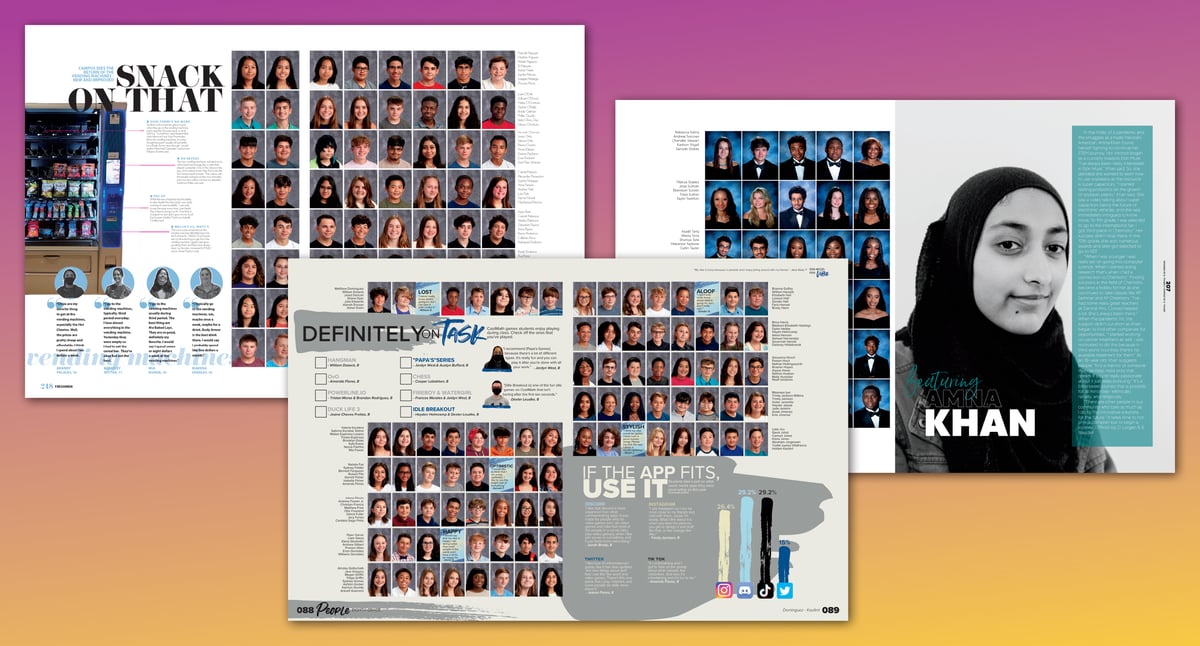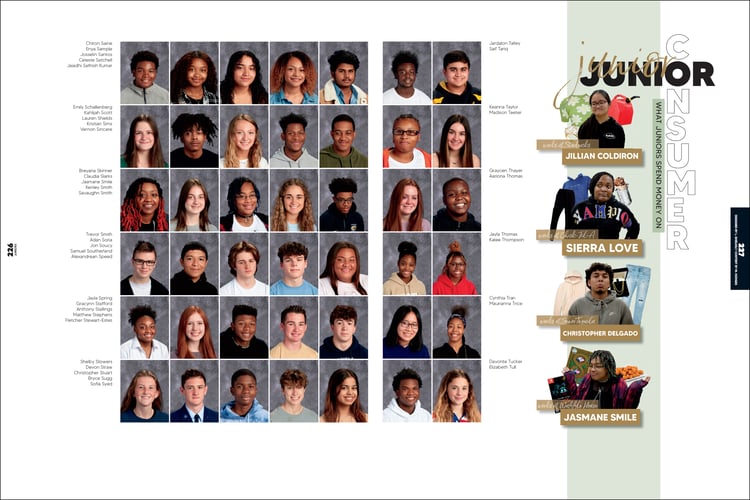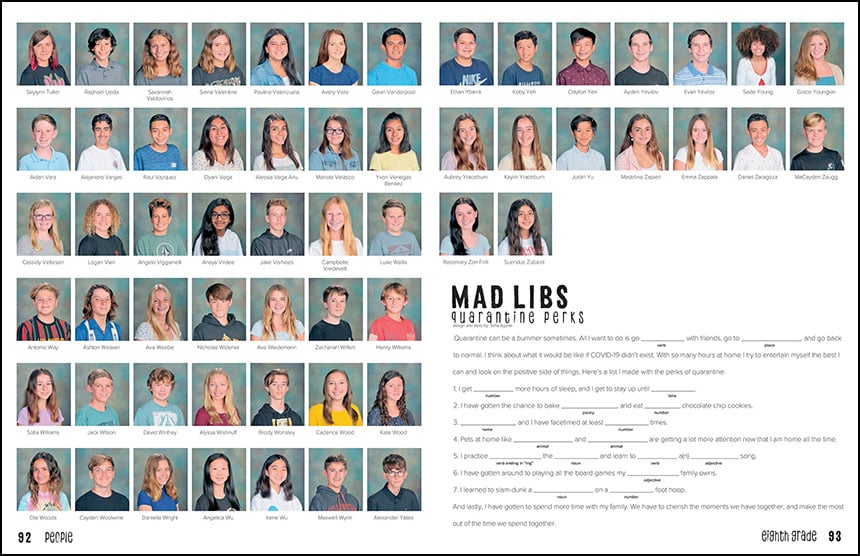
It’s all about the people. While other parts of the yearbook focus on classes, clubs, events and sports, the people section is an all-inclusive endeavor. A reference tool, it serves as a directory for all students who attended your school. It’s also an incredible opportunity to showcase those students. The yearbook is, after all, about the people.
Strategize to gather additional portraits
Make it a priority to include students who didn’t take a picture. Consider utilizing EZPix to gather selfie portraits—using the eMarketing program, parents will receive a customized email and simple directions for submitting an image. You might also try social media, phone calls and faculty help to gather missing portraits.
If all attempts fail, try including the missing students in a different way in your people section. At the least, include a not pictured list. Consider running their school picture from the previous year. Another option is to create coverage dedicated to those students, possibly feature profiles or mini-stories. It could be as simple as running a module with quotes from each person.
Smaller numbers, bigger coverage
If you have less school pictures, we urge you not to cut people pages. Use the additional space to include more feature coverage. This is a chance to include even more students than ever before.
Feature coverage in the people section can provide a fun contrast to the blocks of portraits. Virtually any of the ideas we suggested in our student life coverage post could be pared down to use in the people section.
 Our student life ideas post included a four-page handout with ideas, almost all that could be used in the people section on a smaller scale.
Our student life ideas post included a four-page handout with ideas, almost all that could be used in the people section on a smaller scale.
With 170-plus ideas, there are bound to be a few you didn’t use in another part of the book. Without covering those topics again, here are additional ideas to make your people section a compelling part of the book.
People coverage ideas
Profiles The bread and butter of people sections. Profiles check several boxes—the human interest angle, unusual or unknown stories, storytelling in multiple formats. Consider in-depth stories, mini-stories, Q&As and hearty quotes to feature the person in the best way. Often staffs dedicate an entire page to the profile, but you could also do shorter versions in a vertical module or half-page format. Consider profiles on students with businesses, creative hobbies and unusual collections. Feature people involved in sports and outdoor activities (horseback riding, motocross, hiking). Write about budding musicians and TikTok sensations.

Rather than featuring one profile, Little Rock Central High School dedicated a half page to four students in their junior section.
Faculty Don’t limit your coverage to just the students. The faculty and staff have great stories to share too. Cover any of the above topics or go another route. Feature the school’s alumni and their senior portraits. Try a matching quiz of familiar faculty sayings or a feature story on married teachers. Spotlight classroom decorations, desk tchotchkes or favorite coffee mugs. Run a photo module of teacher and pet selfies.
.jpg?width=750&height=500&name=22_Venice%20HS%20120-121%20(1).jpg) 2021, Venice High School included a guessing game in their faculty section, asking students to guess which classroom or office the objects belong to.
2021, Venice High School included a guessing game in their faculty section, asking students to guess which classroom or office the objects belong to.
Interactive coverage A way to personally connect students to the book, it’s also ideal in a challenging year for photos. Design a typographic module that uses fill in the blanks, this or that modules, open-ended questions or a flowchart. Modules could range from school-related topics (their schedule for instance) to pop culture and favorite things. Interactive coverage also provides another opportunity to connect to the theme verbally and conceptually. For example, for an “Uncertain” theme, a this-or-that module could focus on the opposite—things people are certain about. Students could circle things their favorites (waffles or pancakes, Apple or Android) with the headline “Definitely, yes” or “For certain.”
 In their eighth grade section, San Elijo Middle School created interactive coverage with a Mad Libs module about quarantine perks.
In their eighth grade section, San Elijo Middle School created interactive coverage with a Mad Libs module about quarantine perks.
Text-only modules Similar to interactive coverage, this type of module doesn’t rely on visuals. Collect answers via in-person interviews, texts, social media and/or Google forms. Run all the text in quote modules, adding color or your graphic element for visual interest. Depending on the question, answers could vary from a single word to a lengthy quote. Some potential topics:
- Best memory from this year
- Best school tradition
- Funniest moment
- Teacher who has influenced you the most
- Favorite class this year
- What class do you wish you could take a second time?
- You know you’re a freshman/sophomore/junior/senior when…
- One word to describe freshman/sophomore/junior/senior year
- How is high school different from middle school? (freshmen)
- What surprised you about high school? (freshmen)
- How have you changed since freshman year? (sophomores)
- Best part of being a sophomore? (sophomores)
- Driving disasters (juniors)
- Hardest part of junior year (juniors)
- Advice you’d give your freshman self (seniors)
- What will you miss about high school? (seniors)
- Go-to place in the school
- High school in three emojis
- My life in three words
- Class you were surprised to like
- English book you secretly loved
- Favorite read this year
- Favorite pastime this year
- What do you do when bored?
- Boring fact about you
- Best trend
- You’re not embarrassed to admit…
- What are you afraid of?
- Something you’re passionate about
- Something you say too much
- Guilty pleasure
- Movie you could watch over and over
- Favorite go-to snack
- Favorite comfort food
- Favorite Girl Scout cookie
- Favorite Sonic drink
- Best sparkling water
- Song that puts you in a good mood
- Song you know all the words by heart
- If you were president, what would you do?
- Other than your phone, what’s something you can’t live without?
- What’s something boring about you?
- Last text message you sent
- In 10 years, I’ll be…

